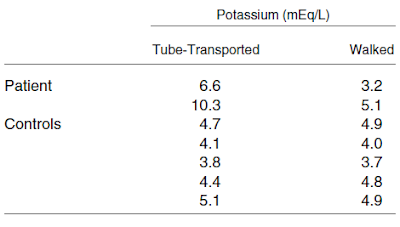 Not long ago while on call I received a midnight consult for hyperkalemia. The patient had a history notable for CLL, who was electively admitted to for induction chemotherapy. Prior to this admission, he had received no previous chemotherapeutic agents. On arrival to the floor he was found to have a potassium of 6.5 mmol/L, and received IV insulin, kayexalate, and albuterol for medical management. Reportedly he had no EKG changes at that time. Despite this medical management, repeat labs that night demonstrated a K of 9.3 with ‘some hemolysis’, which prompted an urgent renal consult from an understandably concerned intern.
Not long ago while on call I received a midnight consult for hyperkalemia. The patient had a history notable for CLL, who was electively admitted to for induction chemotherapy. Prior to this admission, he had received no previous chemotherapeutic agents. On arrival to the floor he was found to have a potassium of 6.5 mmol/L, and received IV insulin, kayexalate, and albuterol for medical management. Reportedly he had no EKG changes at that time. Despite this medical management, repeat labs that night demonstrated a K of 9.3 with ‘some hemolysis’, which prompted an urgent renal consult from an understandably concerned intern.Wbc- 270,000, Hgb- 11.3 g/dL, plt- 99,000, uric acid- 6.7 mg/dL, LDH- 690 U/L, Creat.- 1.1 mg/dL, calcium- 8.5 mg/dL, Phosphorus- 4.8 mg/dL, Potassium- 9.3 mmol/L.
The story just wasn’t adding up, so I went to the literature and performed a search on CLL and hyperkalemia, and came across this interesting publication in AJKD…
 First described in the 1950s, pseudohyperkalemia is defined as a spurious elevation of the serum potassium, occurring when potassium is released in vitro from cells in a collected blood sample. This may be seen in a variety of myeloproliferative disorders, typically those with marked leukocytosis or thrombocytosis, or as a result of improper collection technique (fist clenching during phlebotomy, a delay in the processing of the sample, or even the use of a pneumatic tube transport system). For a quick review look at Nate’s prior post.
First described in the 1950s, pseudohyperkalemia is defined as a spurious elevation of the serum potassium, occurring when potassium is released in vitro from cells in a collected blood sample. This may be seen in a variety of myeloproliferative disorders, typically those with marked leukocytosis or thrombocytosis, or as a result of improper collection technique (fist clenching during phlebotomy, a delay in the processing of the sample, or even the use of a pneumatic tube transport system). For a quick review look at Nate’s prior post.
- vacutainer draw from a venous catheter into a heparin/lithium tube, pneumatic tube transport (the same as the initial sample).
- venous sample draw into a heparinized arterial blood gas syringe (no lithium), ran in the ICU machine.
- vacutainer draw from venous catheter into a heparin/lithium tube, walked to the laboratory
- venous draw into a heparinized arterial blood gas syringe (no lithium), walked to the laboratory.
- venous draw with a syringe (no vacutainer), poured gently into a heparin/lithium tube, and walked to the laboratory.
 You can see that the primary factor responsible for the falsely elevated potassium in this case was the use of the pneumatic tubing system.
You can see that the primary factor responsible for the falsely elevated potassium in this case was the use of the pneumatic tubing system.




I've also had similar episodes. That and also an initially disturbing pseudo-type 1 respiratory failure due to continued in vitro high level metabolism of the high cell load in the sample of such pts. Confirmed by performing timed samples and using citrate tubes. Big danger of further unnecessary activity overnight!
checking plasma potassium will help to clarify.I had similar experience just the other night on-call.thanks!